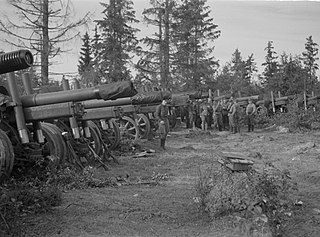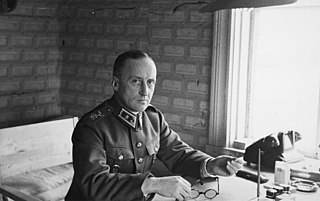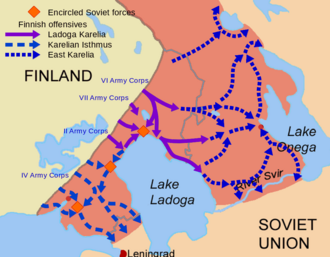
The Continuation War, also known as Second Soviet-Finnish war, was a conflict fought by Finland and Nazi Germany, against the Soviet Union (USSR) from 1941 to 1944, as a part of World War II. In Soviet historiography, the war was called the Finnish Front of the Great Patriotic War. Germany regarded its operations in the region as part of its overall war efforts on the Eastern Front and provided Finland with critical material support and military assistance, including economic aid.

Hjalmar Fridolf Siilasvuo was a Finnish lieutenant general, a knight of the Mannerheim Cross and a member of the Jäger Movement. He participated in the Eastern Front of World War I, the Finnish Civil War, the Winter War, Continuation War and the Lapland War.

Paavo Juho Talvela was a Finnish general of the infantry, Knight of the Mannerheim Cross and a member of the Jäger movement. He participated in the Eastern Front of World War I, the Finnish Civil War, the Finnish Kinship Wars, the Winter War and the Continuation War.
The 6th Division was a unit of the Finnish Army during the Continuation War. Subordinated to the German XXXVI Corps, the division took part in the German-led Operation Arctic Fox in 1941. In 1943, the division was moved to Eastern Karelia, from where it was moved to the Karelian Isthmus following the start of the 1944 Soviet Vyborg–Petrozavodsk offensive. Following the Moscow armistice, the division also took part in the Lapland War against the German forces remaining in Finnish Lapland.
The III Corps was a corps of the Finnish Army during the Continuation War, where Finland fought alongside Nazi Germany against the Soviet Union. Formed from the peacetime V Corps and subordinated to the German Army High Command Norway, III Corps fought initially in northern Finland on the flank of the German XXXVI Corps, participating in the Finno-German Operation Arctic Fox. In February 1944, it was moved to the Karelian Isthmus just prior to the launch of the Soviet Vyborg–Petrozavodsk offensive. Following the Moscow Armistice, III Corps took overall command of the Finnish forces participating in the Lapland War, the removal of German forces from northern Finland.
The 3rd Division was a unit of the Finnish Army during the Continuation War. It initially fought in the northern Finland, participating in the Finno-German Operation Arctic Fox. In 1944, it was transferred to the Karelian Isthmus to defend against the Soviet Vyborg–Petrozavodsk offensive. Following the Moscow Armistice in 1944, the division was moved to Oulu and participated in the Lapland War.
There were two waves of the Finnish prisoners of war in the Soviet Union during World War II: POWs during the Winter War and the Continuation War.
The 8th Army was a field army of the Soviet Red Army during the Second World War.
5th Division was a Finnish Army division in the Continuation War. The division was formed by Etelä-Häme military province from the men in Kanta-Häme and Lounais-Häme civil guard districts.
7th Division was a Finnish Army division in the Continuation War. The division was formed Savo-Karjala military province from the men in Pohjois-Savo and Pohjois-Karjala civil guard districts.

Soviet prisoners of war in Finland during World War II were captured in two Soviet-Finnish conflicts of that period: the Winter War and the Continuation War. The Finns took about 5,700 POWs during the Winter War, and due to the short length of the war they survived relatively well. However, during the Continuation War the Finns took 64,000 POWs, of whom almost 30 percent died.

Antero Johannes Svensson was a Finnish major general, a member of the Jäger Movement and a recipient of the Mannerheim Cross. He participated in the Eastern Front of World War I as a volunteer of the 27th Royal Prussian Jäger Battalion, in the Finnish Civil War as a platoon and squadron commander, the Winter War as a brigade and division commander, and the Continuation War as a division and corps commander.

The Battle of Porlampi, also known as the Battle of Porlammi, was a military engagement fought between the Finnish Army and Red Army from 30 August to 1 September 1941 on the Karelian Isthmus. The battle was fought near the town of Porlampi during the second month of the Continuation War. The battle was a Finnish victory and effectively ended the reconquest of Karelia.

Taavetti Laatikainen was a Finnish General of Infantry and a member of the Jäger movement. He fought in the Eastern Front of World War I, the Finnish Civil War, the Winter War and the Continuation War. During the last of these, he was awarded the Mannerheim Cross of Liberty 2nd Class. Before the Winter War, he commanded both the Reserve Officer School and the Officer Cadet School. He retired in 1948 from the position of Inspector of Infantry.

Einar Nikolai Mäkinen was a Finnish lieutenant general and a member of the Jäger movement. He participated in the Eastern Front of World War I, the Finnish Civil War, the Winter War and the Continuation War. Before the Continuation War, he participated in negotiations with the Germans regarding plans for the war.
The II Corps was a unit of the Finnish Army during the Continuation War. During the war the corps participated in combat first northwest of Lake Ladoga and on the Karelian Isthmus before moving to the Povenets–Lake Segozero region by late 1941. During the Soviet offensive of 1944, the corps conducted a fighting retreat to the region of Ilomantsi, with parts of its forces participating in the subsequent Battle of Ilomantsi.
The IV Corps was a unit of the Finnish Army during the Continuation War. During the 1941 Finnish invasion of the Karelian Isthmus, it encircled three Soviet divisions in the area south of Vyborg before being disbanded. Reconstituted in 1944, the corps was the target of the spearhead of the Soviet Vyborg–Petrozavodsk offensive. Elements of the corps fought in the decisive Battle of Tali-Ihantala at the end of the war.
The V Corps was a unit of the Finnish Army during the Continuation War of 1941–1944. It was first active for a brief time in 1941, and was reactivated in 1942 in the Svir sector during the trench warfare phase of the war. Following the Soviet Vyborg–Petrozavodsk offensive, the corps was moved to the Karelian Isthmus, where it fought in the Battle of Vyborg Bay, stopping a Soviet amphibious operation to cross the Vyborg Bay.
The VI Corps was a unit of the Finnish Army during the Continuation War. During the war, the corps participated in the Finnish invasions of Ladoga Karelia and East Karelia, eventually reaching the Svir where it would spend the trench warfare phase of the war. It was on Svir sector when the Soviet Vyborg–Petrozavodsk offensive began, and had to retreat to north of Lake Ladoga to avoid encirclement.

Aarne Leopold Blick was a Finnish lieutenant general, Knight of the Mannerheim Cross and a member of the Jäger movement. He participated in the Eastern Front of World War I, the Finnish Civil War, the Winter War and the Continuation War.










